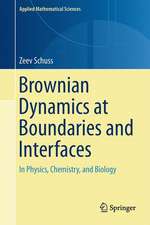Intermediate Mathematical Statistics
Autor G.P. Beaumonten Limba Engleză Paperback – 19 iun 1980
Preț: 377.30 lei
Nou
Puncte Express: 566
Preț estimativ în valută:
72.23€ • 75.08$ • 59.89£
72.23€ • 75.08$ • 59.89£
Carte tipărită la comandă
Livrare economică 08-22 februarie 25
Preluare comenzi: 021 569.72.76
Specificații
ISBN-13: 9780412154805
ISBN-10: 0412154803
Pagini: 250
Ilustrații: XVIII, 250 p.
Dimensiuni: 140 x 216 x 14 mm
Greutate: 0.31 kg
Editura: SPRINGER NETHERLANDS
Colecția Springer
Locul publicării:Dordrecht, Netherlands
ISBN-10: 0412154803
Pagini: 250
Ilustrații: XVIII, 250 p.
Dimensiuni: 140 x 216 x 14 mm
Greutate: 0.31 kg
Editura: SPRINGER NETHERLANDS
Colecția Springer
Locul publicării:Dordrecht, Netherlands
Public țintă
ResearchCuprins
1 Sufficiency.- 1.1 Introduction.- 1.2 Factorization criterion.- 1.3 Distribution of statistics conditional on a sufficient statistic.- 1.4 Joint sufficiency.- 1.5 Minimal sufficiency.- 2 Unbiased point estimators.- 2.1 Introduction.- 2.2 Rao-Blackwell theorem.- 2.3 The role of sufficient statistics.- 2.4 Completeness.- 2.5 Joint completeness.- 2.6 Sufficiency, completeness and independence.- 2.7 Minimum-variance bounds.- 2.8 Computation of a minimum-variance bound.- 2.9 Minimum attainable variance.- 2.10 Mean square error.- 2.11 Two parameters.- 3 Elementary decision theory and Bayesian methods.- 3.1 Comments on classical techniques.- 3.2 Loss functions.- 3.3 Decision theory.- 3.4 Bayes decisions.- 3.5 Using data.- 3.6 Computing posterior distributions.- 3.7 Conjugate distributions.- 3.8 Distribution of the next observation.- 3.9 More than one parameter.- 3.10 Decision functions.- 3.11 Bayes estimators.- 3.12 Admissibility.- 4 Methods of estimation.- 4.1 Introduction.- 4.2 Maximum likelihood estimation.- 4.3 Locating the maximum likelihood estimator.- 4.4 Estimation of a function of a parameter.- 4.5 Truncation and censoring.- 4.6 Estimation of several parameters.- 4.7 Approximation techniques.- 4.8 Large-sample properties.- 4.9 Method of least squares.- 4.10 Normal equations.- 4.11 Solution of the normal equations (non-singular case).- 4.12 Use of matrices.- 4.13 Best unbiased linear estimation.- 4.14 Co variance matrix.- 4.15 Relaxation of assumptions.- 5 Hypothesis testing I.- 5.1 Introduction.- 5.2 Statistical hypothesis.- 5.3 Simple null hypothesis against simple alternative.- 5.4 Applications of the Neyman-Pearson theorem.- 5.5 Uniformly most powerful tests for a single parameter.- 5.6 Most powerful randomized tests.- 5.7 Hypothesis testing as a decision process.- 5.8 Minimax and Bayes tests.- 6 Hypothesis testing II.- 6.1 Two-sided tests for a single parameter.- 6.2 Neyman-Pearson theorem extension (nonrandomized version).- 6.3 Regular exponential family of distributions.- 6.4 Uniformly most powerful unbiased test of ? = ?0 against ? ? ?0.- 6.5 Nuisance parameters.- 6.6 Similar tests.- 6.7 Composite hypotheses-several parameters.- 6.8 Likelihood ratio tests.- 6.9 Bayes methods.- 6.10 Loss function for one-sided hypotheses.- 6.11 Testing ? = ?0 against ? ? ?0.- 7 Interval estimation.- 7.1 One parameter, Bayesian confidence intervals.- 7.2 Two parameters, Bayesian confidence regions.- 7.3 Confidence intervals (classical).- 7.4 Most selective limits.- 7.5 Relationship to best tests.- 7.6 Unbiased confidence intervals.- 7.7 Nuisance parameters.- 7.8 Discrete distributions.- 7.9 Relationship between classical and Bayesian intervals.- 7.10 Large-sample confidence intervals.- Appendix 1 Functions of random variables.- A 1.1 Introduction.- A 1.2 Transformations: discrete distributions.- A1.3 Continuous distributions.- A 1.4 The order statistics.- Appendix 2 The regular exponential family of distributions.- A2.1 Single parameter.- A2.2 Several parameters.- A2.3 The regular exponential family of bivariate distributions.- Further exercises.- Brief solutions to further exercises.- Further reading.- Author index.












